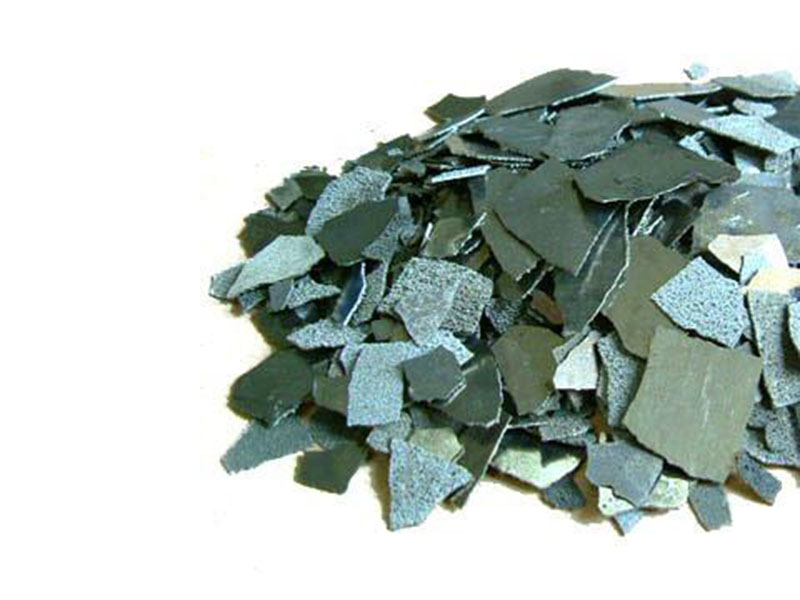What is Electrolytic Manganese?
Electrolytic manganese metal refers to the pure manganese obtained through the process of leaching manganese ore with acid to obtain manganese salt, which is then subjected to electrolysis in an electrolytic cell. Its appearance is similar to iron, presented in irregular flakes, hard and brittle in texture, with one side being shiny and the other rough, ranging in color from silvery white to brown. When processed into powder, it appears silvery gray. It oxidizes easily in the air, dissolves in dilute acids, releasing hydrogen, and can decompose water to release hydrogen at slightly above room temperature.
The preparation of electrolytic manganese metal typically involves mixing raw manganese ore with sulfuric acid to obtain a mixed solution mainly composed of manganese sulfate. After neutralization, impurity removal, and filtration, electrolytic additives are added to prepare the electrolyte, followed by electrolysis. The manganese obtained at the cathode is then subjected to passivation, washing, drying, and other subsequent treatments to obtain electrolytic manganese metal.

Electrolytic Manganese Industry Chain
The electrolytic manganese industry chain is divided into upstream, midstream, and downstream segments.
Upstream Industry: This segment involves raw materials, primarily including manganese ore, manganese carbonate powder, sulfuric acid, etc.
Midstream Industry: This involves the production and supply of electrolytic manganese.
Downstream Industry: Electrolytic manganese is mainly used in the steel, metallurgy, electronics, and chemical industries. The steel industry is the largest application field, particularly in the manufacture of high-performance stainless steel and special steel. Adding electrolytic manganese during the steelmaking process can effectively eliminate impurities such as sulfur and oxygen, enhancing the strength, hardness, and wear resistance of the steel. With the international industrial transfer and the rapid development of China’s national economy, the steel industry in China has made significant achievements, with steel production continuously increasing. Data shows that in 2022, China’s steel production reached 1.34 billion tons, a year-on-year increase of 0.3%.
Electrolytic Manganese Market Status
As the world’s largest producer, consumer, and exporter of electrolytic manganese, China’s industry has developed rapidly in recent years. However, because the electrolytic manganese industry is high in energy consumption and pollution, introducing China’s “dual carbon” goals has led to increasingly stringent environmental policies. In this context, the industry has accelerated its pace of upgrading, continuously eliminating outdated production capacities and strictly controlling new capacities, resulting in a decline in production. In the second half of 2021, the country intensified its “dual control” of energy consumption, causing power shortages in major electrolytic manganese production areas such as Guangxi, Guizhou, and Yunnan, further reducing production. In 2022, due to the continued weakening of electrolytic manganese prices, companies began joint production cuts in the third quarter to stabilize prices, leading to a further decline in production. Data shows that in 2022 China’s electrolytic manganese production was about 1.149 million tons, a year-on-year decrease of 11.9%; the demand was about 874,400 tons, a year-on-year decrease of 7.5%.
Regarding import and export trade, China mainly exports electrolytic manganese. Due to the decline in domestic production capacity and output, export volumes have shown a fluctuating downward trend in recent years. On the import side, from 2015 to 2020, China’s import scale was relatively stable, but from 2021 to 2022, due to the decline in domestic production and significant price increases, import volumes surged. Data shows that in 2022, China’s electrolytic manganese imports were 42,800 tons, a year-on-year increase of 422%, with an import value of 130 million USD, a year-on-year increase of 242.1%; exports were 317,400 tons, a year-on-year decrease of 13.5%, with an export value of 1.04 billion USD, a year-on-year decrease of 6.5%.
Development Trends of Electrolytic Manganese
Benefiting from rapid economic development and continuous improvement in production levels, the demand for electrolytic manganese applications is increasing, and the industry has broad development prospects. However, with the introduction of China’s “dual carbon” goals, environmental policies are becoming increasingly stringent. Coupled with the soaring prices of coal, leading to industrial shutdowns in some regions due to power shortages, the high energy consumption and high pollution nature of the electrolytic manganese industry has faced significant development constraints. To address the industry risks brought by increasingly stringent environmental policies, the most important investment directions for China’s electrolytic manganese industry currently are reducing electrolysis energy consumption and the harmless treatment of electrolytic manganese slag.
In terms of reducing electrolysis energy consumption, as the electrolytic manganese industry continues to develop, researching the impact of anode material structures on reducing electrolysis energy consumption is a crucial direction. Future research should focus on surface engineering techniques to modify the surface of anode materials, enhancing their corrosion resistance and electrical conductivity, while ensuring low costs, simple processes, and environmental friendliness. In addition to applying new energy-saving materials, the electrolytic manganese industry should actively invest in new process research to continuously reduce energy consumption from production details.
Regarding electrolytic manganese slag treatment, companies should adopt comprehensive clean production technologies that combine pollution control at the source of raw materials and auxiliaries, process emission reduction in key stages, and end-cycle treatment of manganese slag and wastewater. They should promote a pollution prevention technology route characterized by energy saving and emission reduction, focusing on pollution prevention, process cleanliness, equipment sealing, mechanized operations, precise measurement, water recycling, and water balance.
